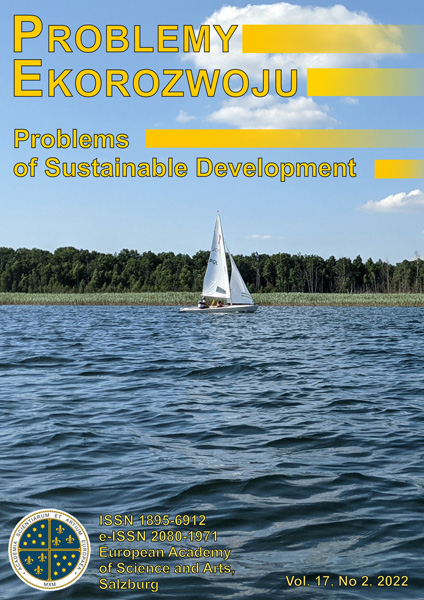ABAYNEH F., GALLE S., ENDALE H., 2021, Sericulture value chain analysis in Gamo Zone, Southern Ethiopia, Journal of Science and Inclusive Development, 3(2): 15-40, https://doi.org/10.20372/jsid/2021-74.
ADAMSKA H., MINTA S., 2017, Sustainable development of agriculture and rural areas in the light of programs of strategic development, Research Papers of Wrocław University of Economics, 491: 11-18, https://doi.org/10.15611/pn.2017.491.01.
DOI: https://doi.org/10.15611/pn.2017.491.01
BIERNAT-JARKA A., TRĘBSKA P., 2018, The importance of organic farming in the context of sustainable development of rural areas in Poland, Acta Scientiarum Polonorum. Oeconomia, 17(2): 39-47, DOI: 10.22630/ASPE.2018.17.2.19.
DOI: https://doi.org/10.22630/ASPE.2018.17.2.19
CACCAM M., MENDOZA T., 2010, Factors affecting productivity and profitability of sericulture-based agroecosystems, New Left Review Journal, 3-4: 73-88.
DALTON H., FITTS M., HU M.M., 2020, The new fashion initiative, Brown University x TNFI Research Project.
DAS N.C., 1994, Banana leaf and bark a new substitute for foam pads and paraffin papers?, Indian Silk, 33(1): 19-20.
DENING X., 2020, 100 pytań o jedwabiu, Wydawnictwo Kwiaty Orientu.
FRANKOWSKI J., ŁOCHYŃSKA M., GRZEŚKOWIAK J., 2021, Energy potential of the white mulberry waste biomass [in]: Book of Abstracts XII International Scientific Agriculture Symposium AGROSYM 2021, p 778.
GRZEŚKOWIAK J., ŁOCHYŃSKA M., 2017, Mulberry silkworm (Bombyx mori L.) - known insect of unknown potential., Wiadomości Zootechniczne, 1:101-105.
GRZEŚKOWIAK J., ŁOCHYŃSKA M., 2021, Prospects and directions of development of mulberry silkworm (Bombyx mori L.) breeding, Przegląd Hodowlany, 6:12-17.
Information on the profession of silkworm breeder, 2018, Ministry of Family, Labor and Social Policy, Labor Market Department, Warsaw.
JARECKI W., TOBIASZ-SALACH R., BOBRECKA-JAMRO D., 2019, Development of organic farming in Poland over the period of 2004-2018, Acta Agrophysica, 26(4): 23-30, https://doi.org/10.31545/aagr/118013.
DOI: https://doi.org/10.31545/aagr/118013
JIANG Y., HUANG R., YAN X., JIA C., JIANG S., LONG T., 2017, Mulberry for environmental protection, Pakistan Journal of Botany, 49(2): 781-788.
KŁODZIŃSKI M., 2012, Policy of rural development, Association of Agricultural and Agribusiness Economists, Scientific Annals, 14(3): 178-181.
KOCISZEWSKI K., 2013, Ecologisation of Polish Agriculture and its Sustainable Development under the Conditions of the European Union Membership, Monografie i Opracowania Uniwersytetu Ekonomicznego we Wrocławiu nr 227, Wrocław.
KOŁODZIEJCZAK A., 2018, Sustainable development of agriculture in Poland, Rozwój regionalny i polityka regionalna, (17/18): 89-102.
KOŁODZIEJCZAK A., Multifunctionality of agriculture as a sustainable development factor of rural areas in Poland, Studia Obszarów Wiejskich, 38: 131-142, https://doi.org/10.7163/SOW.37.7.
DOI: https://doi.org/10.7163/SOW.37.7
KUTKOWSKA B., 2009, Implementation of sustainable development of agriculture and rural areas of Sudety terrains, Biblioteka Regionalisty, 9:89-98.
KUMARESAN M., GEETHA DEVI R.G., RAJADUARI S., SELVARAJU N.G., JAYARAM H., 2008, Performance of Large Scale Farming in Sericulture – An Economic Analysis, Indian Journal of Agricultural Economy, 63(4): 641-652.
ŁOCHYŃSKA M., 2016, Poradnik hodowcy jedwabnika morwowego, Instytut Włókien Naturalnych i Roślin Zielarskich, Poznań, ISBN 978-83-928618-7-4.
ŁOCHYŃSKA M., 2018, Innowacyjne kierunki wykorzystania surowców z jedwabiu, Rolniczy Festiwal Nauki.
ŁOCHYŃSKA M., FRANKOWSKI J., 2018, The biogas production potential from silkworm waste, Waste Management, 79: 564-570, https://doi.org/10.1016/j.wasman.2018.08.019.
DOI: https://doi.org/10.1016/j.wasman.2018.08.019
ŁOCHYŃSKA M., FRANKOWSKI J., 2020, Impact of silkworm excrement organic fertilizer on hemp biomass yield and composition, Ecological Engineering, 20(10): 63-71, https://doi.org/10.12911/22998993/112858.
DOI: https://doi.org/10.12911/22998993/112858
ŁOCHYŃSKA M., FRANKOWSKI J., 2021, The effects of silkworm excrement organic fertilizer on the hemp yield. Journal of Natural Fibers, https://doi.org/10.1080/15440478.2021.1921665.
DOI: https://doi.org/10.1080/15440478.2021.1921665
ŁOCHYŃSKA M., OLESZAK G., 2011, Multi-use of the white mulberry (Morus alba L.), Ecological Questions 15: 91-95, https://doi.org/10.12775/v10090-011-0040-5.
DOI: https://doi.org/10.2478/v10090-011-0040-5
MANJUNATH R.N., KUMAR A., KUMAR K.P.A., Utilisation of sericulture waste by employing possible approaches, Contaminants in agriculture – sources, impacts and management.
MINTA S., TAŃSKA-HUS B., NOWAK M., 2013, Koncepcja wdrożenia produktu regionalnego ‘Wołowina Sudecka’ w kontekście ochrony środowiska, Rocznik Ochrona Środowiska, 15: 2887-2898.
MONDAL M., TRIVEDY K., KUMAR N.S., 2007, The silk proteins, sericin and fibroin in silkworm, (Bombyx mori L.) – a review, Caspian Journal of Environmental Sciences, 5, (2): 63-76.
PADAMWAR M.N., PAWAR A.P., 2004, Silk sericin and its applications: a review, Journal of Scientific & Industrial Research, 63: 323-329.
PATIL B.R., SINGH K.K., PAWAR S.E., MAARSE L., OTTE J., 2009, Sericulture: An alternative source of income to enhance the livelihoods of small-scale farmers and tribal communities, Pro-Poor Livestock Policy Initiative, A Living from Livestock Research Report.
PILICHOWSKI A., 2018, Grupy producentów w rolnictwie. Refleksja socjologiczna, Wieś i Rolnictwo, 1(178): 97-122, https://doi.org/10.53098/wir012018/06.
DOI: https://doi.org/10.53098/wir012018/06
POPOVYCH A., 2019, Beekeeping sector as a form of enterprise family history: analysis socio-economic. Kwartalnik Nauk o Przedsiębiorstwie, (4): 69-78, https://doi.org/10.5604/01.3001.0013.6508.
DOI: https://doi.org/10.5604/01.3001.0013.6508
RAVEESHA S., KUMAR K.A., BAI D.S., 2016, A socio-economic analysis of women’s participation in sericulture, Advance Research Journal of Social Science, 7 (1): 55-61, https://doi.org/10.15740/HAS/ARJSS/7.1/55-61.
DOI: https://doi.org/10.15740/HAS/ARJSS/7.1/55-61
ROBERTSON G.F., HARWOOD R., 2001, Agriculture, sustainable, Encyclopedia of Biodiversity, National Academy Press, Washington.
DOI: https://doi.org/10.1016/B0-12-226865-2/00008-0
SĘKOWSKI M., 2016, Gospodarka o obiegu zamkniętym – szanse dla rolnictwa i leśnictwa, Centrum Doradztwa Rolniczego w Brwinowie.
SHEVCHENKO T., VAVREK R., DANKO Y., GUBANOVA O., CHOVANCOVA J., MYKHAILOVA L., 2021, Clarifying a Circularity Phenomenon in a Circular Economy under the Notion of Potential, Problemy Ekorozwoju/ Problems of Sustainable Development, 16 (1): 79-89, https://doi.org/10.35784/pe.
DOI: https://doi.org/10.35784/pe.2021.1.09
SINGH G.B., RAJAN R.K., INOKUCHI T., HIMANTHARAJ M.T., MEENAL A., 1994, Plastic bottle brush mountages for better cocoon quality and reliability, Indian Silk, 33 (3): 29-32.
SINGH G.P., SHIVAKUMAR G.R., KUMAR V., RAMAN K.V.A., MAGADUM S.B., KAMBLE C.K., DATTA R.K., 1994, Banana leaf – an alternative to paraffin paper, Indian Silk, 35 (1): 21-23.
SOBIESIAK-PENSZKO P., PAZDERSKI F., 2019, Perspektywy zrównoważonego rolnictwa w Polsce. Analiza społeczno-polityczna, Fundacja Instytut Spraw Publicznych, Warszawa.
STEPHAN-GIERMEK K., 2019, An Introduction to Sustainability in Sericulture: Systems of Sustainable Development in Rural Agricultural Regions of South East Asia.
VATHSALA T.V., 1994, Creativity in cocoon crafts, Indian Silk, 36 (2): 17-22.
World Commission on Environment and Development (WCED), 1987, Our Common Future, Oxford University Press, Oxford, New York.
WU X., HE K., CIRKOVIC-VELICKOVIC T., LIU Z., 2021, Nutritional, functional and allergenic properties of silkworm pupae, Food Science and Nutrition, 9(8): 4655-4665, https://doi.org/10.1002/fsn3.2428.
DOI: https://doi.org/10.1002/fsn3.2428







